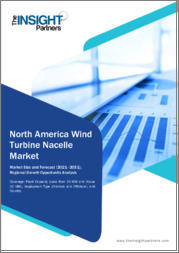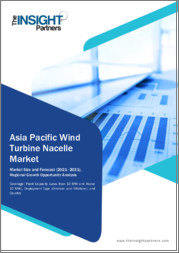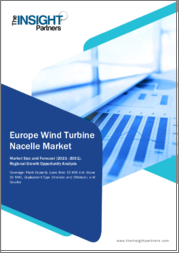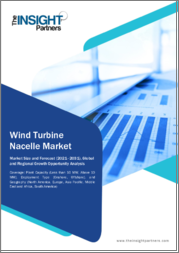
|
시장보고서
상품코드
1513391
세계의 풍력 터빈용 나셀 시장 : 용량별, 전개별, 최종 용도별, 부품별 - 기회 분석 및 산업 예측(2024-2033년)Wind Turbine Nacelle Market By Capacity, By Deployment, By End Use, By Component : Global Opportunity Analysis and Industry Forecast, 2024-2033 |
||||||
세계 풍력 터빈용 나셀 시장 규모는 2023년 223억 달러에 달할 것으로 예상되며, 2024-2033년 연평균 6.3% 성장하여 2033년에는 403억 달러에 달할 것으로 전망됩니다.
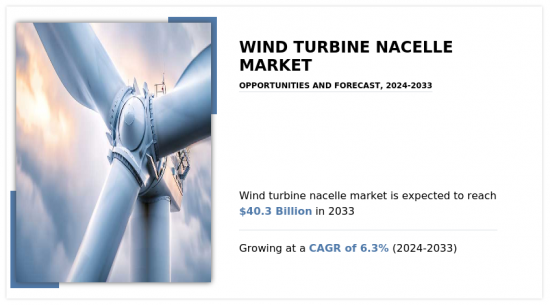
풍력 터빈용 나셀은 타워 상단에 위치한 밀폐된 구조물로, 터빈의 주요 부품이 들어있는 구조물입니다. 나셀은 일반적으로 발전기, 기어박스, 브레이크 어셈블리, 요 메커니즘 및 기타 풍력에너지를 전력으로 변환하는 데 필수적인 요소들을 포함합니다. 나셀은 바람을 향해 배치되어 블레이드가 에너지를 최대한 활용할 수 있도록 합니다. 바람의 방향을 모니터링하고, 블레이드의 피치를 조정하고, 출력을 조절하는 등 터빈의 작동을 제어하는 데 중요한 역할을 합니다.
재생에너지에 대한 수요 증가와 풍력 터빈 기술의 발전으로 인해 전 세계적으로 풍력 발전소 건설이 급증하고 있습니다. 이러한 풍력 발전소는 바람의 운동 에너지를 이용하여 전력으로 변환하기 위해 효율적이고 신뢰할 수 있는 풍력 터빈용 나셀에 의존하고 있습니다. 그 결과, 풍력 발전 용량을 확대하고 재생에너지 목표를 달성해야 하는 필요성으로 인해 최근 몇 년 동안 나셀에 대한 수요가 크게 증가했습니다. 이러한 모든 요인들이 예측 기간 동안 풍력 터빈용 나셀 시장의 수요를 견인할 것으로 예상됩니다.
그러나 풍력 터빈용 나셀 생산은 일반적으로 제조 공정과 관련된 규모의 경제가 충분히 최적화되어 있지 않으며, 특히 소규모 또는 저빈도 주문의 경우 이러한 경향이 더욱 두드러집니다. 이는 단가를 상승시키고, 특히 생산량이 적은 제조업체의 경우 비용 경쟁력을 저해하는 요인으로 작용합니다. 또한, 성능, 효율성 및 신뢰성을 향상시키기 위해 나셀 설계의 지속적인 혁신과 기술 발전이 필요하기 때문에 연구개발 비용이 증가하여 풍력 터빈용 나셀의 전체 비용을 더욱 증가시키는 요인으로 작용합니다. 이러한 모든 요인들이 풍력 터빈용 나셀 시장의 성장을 저해하고 있습니다.
나셀 설계에 디지털화 및 IoT를 도입하면 원격 모니터링 및 제어 기능이 강화되어 운영자는 인터넷 연결이 가능한 곳이라면 어디서든 풍력 터빈에 접속하여 관리할 수 있습니다. 이러한 원격 모니터링 기능은 실시간 성능 최적화를 용이하게 하며, 운영자는 로터 속도 및 블레이드 피치와 같은 운영 파라미터를 조정하여 에너지 생산을 극대화하고 변화하는 환경 조건에 적응할 수 있게 해줍니다. 이러한 모든 요소들은 예측 기간 동안 풍력 터빈용 나셀 시장에 새로운 성장 기회를 제공할 것으로 예상됩니다.
풍력 터빈용 나셀 시장은 부품, 용량, 배치, 용도, 지역별로 분류됩니다. 부품별로 시장은 기어박스, 발전기, 전자 시스템, 기타로 분류됩니다. 용량 기준으로 시장은 2MW-4MW, 2MW 미만, 4MW 이상으로 분류됩니다. 배치에 따라 시장은 육상과 해상으로 나뉩니다. 최종 용도별로 시장은 유틸리티와 산업용으로 나뉩니다. 지역별로는 북미, 유럽, 아시아태평양, 라틴아메리카, 중동 및 아프리카로 분석됩니다.
부품별로는 기타 부문이 2023년 풍력 터빈용 나셀 세계 시장 점유율의 5분의 2 미만을 차지했으며, 예측 기간 동안에도 그 우위를 유지할 것으로 전망됩니다. 기타 부문에는 요 시스템 부품, 블레이드 피치 시스템, 센서, 환기 시스템 등이 포함됩니다. 요 시스템 부품은 터빈 로터를 바람을 향하도록 방향을 잡아주는 역할을 하며, 에너지 포획을 극대화하고 터빈 성능을 최적화하는 데 매우 중요합니다. 요 시스템은 바람의 상태가 변할 때 로터가 바람을 향하도록 나셀의 방향을 신속하고 정확하게 조정해야 합니다. 또한 블레이드 피치 시스템은 발전량을 최적화하고 변동하는 풍속과 풍향에 대응하기 위해 풍력 터빈 블레이드의 각도를 조정하는 데 중요한 역할을 합니다.
용량별로는 2MW-4MW 부문이 2023년 풍력 터빈용 나셀 세계 시장 점유율의 절반 이하를 차지했으며, 예측 기간 동안에도 그 우위를 유지할 것으로 예상됩니다. 기술 발전은 풍력 터빈용 나셀의 대규모화를 가능하게 하는 데 중요한 역할을 하고 있습니다. 재료, 설계 및 제조 공정의 끊임없는 기술 혁신으로 보다 효율적이고 신뢰할 수 있는 부품이 개발되어 더 크고 강력한 터빈을 건설할 수 있게 되었습니다. 이러한 발전에는 첨단 복합재료 및 탄소섬유와 같은 경량 재료의 사용이 포함되어 터빈 구조의 강도 대 중량 비율을 높이고 전체 비용을 절감합니다.
전개별로는 육상 부문이 2023년 첨가제 시장 점유율의 4분의 3 이상을 차지했으며, 예측 기간 동안에도 우위를 유지할 것으로 보입니다. 지속가능성과 탈탄소화에 대한 관심이 높아지면서 풍력 터빈의 보급이 가속화되고 있습니다. 각국 정부와 정책 입안자들은 기후변화를 완화하고 이산화탄소 배출량을 줄이기 위해 야심찬 재생에너지 목표를 수립하고 있습니다. 비교적 성숙한 기술과 풍부한 자원을 보유한 육상 풍력에너지는 이러한 목표를 달성하는 데 있어 매우 중요한 역할을 하고 있습니다. 이에 따라 육상 풍력 발전소 개발에 대한 정치적, 규제적 지원이 증가하고 있으며, 육상 풍력 터빈용 나셀에 대한 유리한 시장 조건이 조성되고 있습니다.
최종 용도별로는 유틸리티 분야가 2023년 풍력 터빈용 나셀 세계 시장 점유율의 4분의 5 이상을 차지했으며, 예측 기간 동안에도 그 우위를 유지할 것으로 전망됩니다. 기존 전원 대비 풍력에너지의 비용 경쟁력이 풍력 터빈용 나셀에 대한 유틸리티 규모의 투자를 촉진하고 있습니다. 또한, 기술 발전, 규모의 경제, 제조 비용의 감소로 인해 풍력 발전의 균등화발전단가(LCOE)가 크게 낮아지고 있습니다. 이에 따라 전력회사들은 전력 수요를 충족시킬 수 있는 비용 효율적인 솔루션으로 풍력 발전, 특히 풍력 자원이 풍부한 지역에서 풍력 발전에 점점 더 많은 관심을 기울이고 있습니다.
아시아태평양은 2023년 풍력 터빈용 나셀 세계 시장 점유율의 절반 이하를 차지했으며, 예측 기간 동안에도 그 우위를 유지할 것으로 예상됩니다. 아시아태평양의 에너지 인프라가 빠르게 확장되고 전력 수요가 증가함에 따라 풍력 발전 및 나셀과 같은 관련 부품에 큰 시장 기회가 창출되고 있습니다. 깨끗하고 지속가능한 에너지원에 대한 수요 증가에 대응하기 위해 육상 및 해상에서 풍력 발전 프로젝트가 개발되고 있으며, 이는 풍력 터빈용 나셀의 필요성을 더욱 증가시키고 있습니다.
주요 조사 결과
- 용량별로는 2MW-4MW 부문이 예측 기간 동안 6.6%의 CAGR로 가장 빠르게 성장할 것으로 예상됩니다.
- 전개별로 보면 육상 부문은 예측 기간 동안 가장 빠른 CAGR로 성장할 것으로 예상됩니다.
- 최종 용도별로는 유틸리티 분야가 예측 기간 동안 6.3%의 CAGR로 가장 빠른 성장을 보일 것으로 예상됩니다.
- 지역별로는 아시아태평양이 2022년 매출에서 가장 높은 점유율을 차지할 것으로 예상됩니다.
이해관계자를 위한 주요 이점
- 이 보고서는 2023-2033년 풍력 터빈용 나셀 시장 분석의 시장 부문, 현재 동향, 추정 및 동향, 역학을 정량적으로 분석하여 풍력 터빈용 나셀 시장의 유력한 기회를 식별합니다.
- 시장 촉진요인, 시장 억제요인, 시장 기회와 관련된 정보와 함께 시장 조사를 제공합니다.
- Porter's Five Forces 분석은 이해 관계자가 이익 중심의 비즈니스 결정을 내리고 공급업체와 공급업체의 네트워크를 강화할 수 있도록 구매자와 공급업체의 잠재력을 강조합니다.
- 풍력 터빈용 나셀 시장의 세분화를 자세히 분석하여 시장 기회를 파악할 수 있습니다.
- 각 지역의 주요 국가는 세계 시장에 대한 수익 기여도에 따라 매핑되어 있습니다.
- 시장 기업의 포지셔닝은 벤치마킹을 용이하게 하고 시장 기업의 현재 위치를 명확하게 이해할 수 있습니다.
- 지역별 및 세계 풍력 터빈용 나셀 시장 동향, 주요 기업, 시장 부문, 응용 분야, 시장 성장 전략 등에 대한 분석이 포함됩니다.
목차
제1장 소개
제2장 주요 요약
제3장 시장 개요
- 시장 정의와 범위
- 주요 조사 결과
- 영향요인
- 주요 투자 기회
- Porter's Five Forces 분석
- 시장 역학
- 성장 촉진요인
- 성장 억제요인
- 기회
- 주요 규제 분석
제4장 풍력 터빈용 나셀 시장 : 용량별
- 개요
- 2MW-4MW
- 2MW 미만
- 4MW 이상
제5장 풍력 터빈용 나셀 시장 : 용도별
- 개요
- 육상
- 해양
제6장 풍력 터빈용 나셀 시장 : 최종사용자별
- 개요
- 유틸리티
- 산업용
제7장 풍력 터빈용 나셀 시장 : 부품별
- 개요
- 기어박스
- 발전기
- 전자 시스템
- 기타
제8장 풍력 터빈용 나셀 시장 : 지역별
- 개요
- 북미
- 미국
- 캐나다
- 멕시코
- 유럽
- 독일
- 영국
- 스웨덴
- 핀란드
- 프랑스
- 스페인
- 기타 유럽
- 아시아태평양
- 중국
- 인도
- 일본
- 호주
- 한국
- 기타 아시아태평양
- 라틴아메리카, 중동 및 아프리카
- 브라질
- 남아프리카공화국
- 사우디아라비아
- 아랍에미리트
- 기타 라틴아메리카, 중동 및 아프리카
제9장 경쟁 상황
- 소개
- 주요 성공 전략
- 주요 10개사 제품 매핑
- 경쟁 대시보드
- 경쟁 히트맵
- 주요 기업의 포지셔닝, 2023년
제10장 기업 개요
- Vestas
- Goldwind
- GE VERNOVA
- Siemens Gamesa Renewable Energy
- NORDEX SE
- Envision Group
- ENERCON Global GmbH
- Suzlon Energy Limited
- Mingyang Smart Energy Group
- Windey Energy Technology Group Co.,Ltd.
The global wind turbine nacelle market was valued at $22.3 billion in 2023, and is projected to reach $40.3 billion by 2033, growing at a CAGR of 6.3% from 2024 to 2033.

The nacelle of a wind turbine is the enclosed structure at the top of the tower where the turbine's key components are housed. It typically contains the generator, gearbox, brake assembly, yaw mechanism, and other essential elements that facilitate the conversion of wind energy into electrical power. The nacelle is positioned to face into the wind, allowing the blades to capture maximum energy. It plays a crucial role in controlling the turbine's operation, including monitoring wind direction, adjusting blade pitch, and regulating power output.
Rise in demand for renewable energy, coupled with advancements in wind turbine technology, has led to a surge in the deployment of wind farms across the globe. These wind farms rely on efficient and reliable wind turbine nacelles to harness the kinetic energy of the wind and convert it into electricity. As a result, the demand for nacelles has witnessed a significant upswing in recent years, driven by the need to expand wind power capacity and meet renewable energy targets. All these factors are expected to drive the demand for the Wind turbine nacelle market during the forecast period.
However, the economies of scale typically associated with manufacturing processes are not fully optimized in the production of wind turbine nacelles, especially for smaller or less frequent orders. This drives up unit costs and hinders cost competitiveness, particularly for manufacturers operating at lower production volumes. In addition, the need for continuous innovation and technological advancement in nacelle design to improve performance, efficiency, and reliability adds to research and development expenses, further contributing to the overall cost of wind turbine nacelles. All these factors hamper the wind turbine nacelle market growth.
The incorporation of digitalization and IoT into nacelle design enhances remote monitoring and control functions that help operators to access and manage wind turbines from any location with internet connectivity. This remote monitoring functionality facilitates real-time performance optimization, enabling operators to adjust operating parameters, such as rotor speed and blade pitch, to maximize energy production and adapt to changing environmental conditions. All these factors are anticipated to offer new growth opportunities for the wind turbine nacelle market during the forecast period.
The Wind turbine nacelle market is segmented on the basis of components, capacity, deployment, application, and region. On the basis of components, the market is categorized into gearbox, generator, electronic systems, and others. On the basis of capacity, the market is categorized into 2 MW to 4 MW, less than 2 MW, and above 4 MW. On the basis of deployment, the market is bifurcated into onshore, and offshore. On the basis of end use, the market is divided into utilities and industrial. Region-wise, the market is analyzed across North America, Europe, Asia-Pacific, and LAMEA.
By components, the others segment accounted for less than two-fifths of global wind turbine nacelle market share in 2023 and is expected to maintain its dominance during the forecast period. In other segment include yaw system components, blade pitch system, sensors, and ventilation systems. The yaw system components, responsible for orienting the turbine rotor into the wind, are crucial for maximizing energy capture and optimizing turbine performance. As wind conditions change, the yaw system must swiftly and accurately adjust the nacelle's orientation to ensure the rotor is facing the wind direction, thereby maximizing energy extraction. In addition, blade pitch systems play a vital role in regulating the angle of wind turbine blades to optimize power generation and respond to fluctuating wind speeds and directions.
By capacity, the 2 MW to 4 MW segment accounted for less than half of global wind turbine nacelle market share in 2023 and is expected to maintain its dominance during the forecast period. Technological advancements play a crucial role in enabling the upscaling of wind turbine nacelles. Continuous innovations in materials, design, and manufacturing processes have led to the development of more efficient and reliable components, allowing for the construction of larger and more powerful turbines. These advancements include the use of lightweight materials, such as advanced composite materials and carbon fibers, which enhance the strength-to-weight ratio of turbine structures and reduce overall costs.
By deployment, the onshore segment accounted for more than three-fourths additives market share in 2023 and is expected to maintain its dominance during the forecast period. The increase in focus on sustainability and decarbonization is driving the deployment of wind turbines. Governments and policymakers worldwide are implementing ambitious renewable energy targets to mitigate climate change and reduce carbon emissions. Onshore wind energy, with its relatively mature technology and abundant resource availability, plays a crucial role in achieving these targets. As a result, there is growing political and regulatory support for the development of onshore wind farms that create favorable market conditions for onshore wind turbine nacelles.
By end use, the utilities segment accounted for more than four-fifths of global wind turbine nacelle market share in 2023 and is expected to maintain its dominance during the forecast period. The cost competitiveness of wind energy relative to conventional power sources is driving utility-scale investments in wind turbine nacelles. In addition, technological advancements, economies of scale, and declining manufacturing costs have led to significant reductions in the levelized cost of electricity (LCOE) for wind power. As a result, utilities are increasingly turning to wind energy as a cost-effective solution for meeting electricity demand, particularly in regions with favorable wind resources.
Asia-Pacific accounted for less than half of the global wind turbine nacelle market share in 2023 and is expected to maintain its dominance during the forecast period. The Asia-Pacific region's rapidly expanding energy infrastructure and growing electricity demand provide a significant market opportunity for wind energy and associated components such as nacelles. Wind power projects, both onshore and offshore, are being developed to meet this increasing demand for clean and sustainable energy sources, further driving the need for wind turbine nacelles.
Key players in the Wind turbine nacelle market include Vestas, Goldwind, GE VERNOVA, Siemens Gamesa Renewable Energy, NORDEX SE, Envision Group, ENERCON Global GmbH, Suzlon Energy Limited, Mingyang Smart Energy Group, and Windey Energy Technology Group Co.,Ltd. Apart from these major players, there are other key players in the Wind turbine nacelle market. These include China Energy Group, CSIC Haizhuang Windpower, LM Wind Power, MingYang Wind Power Group Limited, Sinovel Wind Group Co., Ltd., United Power, Xinjiang Goldwind Science & Technology Co., Ltd., and Zhejiang Windey Co., Ltd.
Key Findings of the Study
- On the basis of capacity, the 2 MW to 4 MW segment is anticipated to grow at the fastest CAGR of 6.6% during the forecast period.
- By deployment, the onshore segment is anticipated to grow at the fastest CAGR during the forecast period.
- On the basis of end use, the utilities segment is anticipated to grow at the fastest CAGR of 6.3% during the forecast period.
- Region-wise, Asia-Pacific has the highest share in 2022 in terms of revenue.
Key Benefits For Stakeholders
- This report provides a quantitative analysis of the market segments, current trends, estimations, and dynamics of the wind turbine nacelle market analysis from 2023 to 2033 to identify the prevailing wind turbine nacelle market opportunities.
- The market research is offered along with information related to key drivers, restraints, and opportunities.
- Porter's five forces analysis highlights the potency of buyers and suppliers to enable stakeholders make profit-oriented business decisions and strengthen their supplier-buyer network.
- In-depth analysis of the wind turbine nacelle market segmentation assists to determine the prevailing market opportunities.
- Major countries in each region are mapped according to their revenue contribution to the global market.
- Market player positioning facilitates benchmarking and provides a clear understanding of the present position of the market players.
- The report includes the analysis of the regional as well as global wind turbine nacelle market trends, key players, market segments, application areas, and market growth strategies.
Additional benefits you will get with this purchase are:
- Quarterly Update and* (only available with a corporate license, on listed price)
- 5 additional Company Profile of client Choice pre- or Post-purchase, as a free update.
- Free Upcoming Version on the Purchase of Five and Enterprise User License.
- 16 analyst hours of support* (post-purchase, if you find additional data requirements upon review of the report, you may receive support amounting to 16 analyst hours to solve questions, and post-sale queries)
- 15% Free Customization* (in case the scope or segment of the report does not match your requirements, 15% is equivalent to 3 working days of free work, applicable once)
- Free data Pack on the Five and Enterprise User License. (Excel version of the report)
- Free Updated report if the report is 6-12 months old or older.
- 24-hour priority response*
- Free Industry updates and white papers.
Possible Customization with this report (with additional cost and timeline, please talk to the sales executive to know more)
- End user preferences and pain points
- Investment Opportunities
- Product Benchmarking / Product specification and applications
- Product Life Cycles
- Technology Trend Analysis
- Consumer Preference and Product Specifications
- Distributor margin Analysis
- New Product Development/ Product Matrix of Key Players
- Pain Point Analysis
- Patient/epidemiology data at country, region, global level
- Regulatory Guidelines
- Additional company profiles with specific to client's interest
- Additional country or region analysis- market size and forecast
- Expanded list for Company Profiles
- Historic market data
- Import Export Analysis/Data
- Key player details (including location, contact details, supplier/vendor network etc. in excel format)
- List of customers/consumers/raw material suppliers- value chain analysis
- SWOT Analysis
- Volume Market Size and Forecast
Key Market Segments
By Capacity
- 2 MW to 4 MW
- Less than 2 MW
- Above 4 MW
By Deployment
- Onshore
- Offshore
By End Use
- Utilities
- Industrial
By Component
- Gearbox
- Generator
- Electronic Systems
- Others
By Region
- North America
- U.S.
- Canada
- Mexico
- Europe
- Germany
- UK
- Sweden
- Finland
- France
- Spain
- Rest of Europe
- Asia-Pacific
- China
- India
- Japan
- Australia
- South Korea
- Rest of Asia-Pacific
- LAMEA
- Brazil
- South Africa
- Saudi Arabia
- UAE
- Rest of LAMEA
Key Market Players:
- Vestas
- Goldwind
- GE VERNOVA
- Siemens Gamesa Renewable Energy
- NORDEX SE
- Envision Group
- ENERCON Global GmbH
- Suzlon Energy Limited
- Mingyang Smart Energy Group
- Windey Energy Technology Group Co.,Ltd.
TABLE OF CONTENTS
CHAPTER 1: INTRODUCTION
- 1.1. Report description
- 1.2. Key market segments
- 1.3. Key benefits to the stakeholders
- 1.4. Research methodology
- 1.4.1. Primary research
- 1.4.2. Secondary research
- 1.4.3. Analyst tools and models
CHAPTER 2: EXECUTIVE SUMMARY
- 2.1. CXO perspective
CHAPTER 3: MARKET OVERVIEW
- 3.1. Market definition and scope
- 3.2. Key findings
- 3.2.1. Top impacting factors
- 3.2.2. Top investment pockets
- 3.3. Porter's five forces analysis
- 3.4. Market dynamics
- 3.4.1. Drivers
- 3.4.2. Restraints
- 3.4.3. Opportunities
- 3.5. Key Regulation Analysis
CHAPTER 4: WIND TURBINE NACELLE MARKET, BY CAPACITY
- 4.1. Overview
- 4.1.1. Market size and forecast
- 4.2. 2 MW to 4 MW
- 4.2.1. Key market trends, growth factors and opportunities
- 4.2.2. Market size and forecast, by region
- 4.2.3. Market share analysis by country
- 4.3. Less than 2 MW
- 4.3.1. Key market trends, growth factors and opportunities
- 4.3.2. Market size and forecast, by region
- 4.3.3. Market share analysis by country
- 4.4. Above 4 MW
- 4.4.1. Key market trends, growth factors and opportunities
- 4.4.2. Market size and forecast, by region
- 4.4.3. Market share analysis by country
CHAPTER 5: WIND TURBINE NACELLE MARKET, BY DEPLOYMENT
- 5.1. Overview
- 5.1.1. Market size and forecast
- 5.2. Onshore
- 5.2.1. Key market trends, growth factors and opportunities
- 5.2.2. Market size and forecast, by region
- 5.2.3. Market share analysis by country
- 5.3. Offshore
- 5.3.1. Key market trends, growth factors and opportunities
- 5.3.2. Market size and forecast, by region
- 5.3.3. Market share analysis by country
CHAPTER 6: WIND TURBINE NACELLE MARKET, BY END USE
- 6.1. Overview
- 6.1.1. Market size and forecast
- 6.2. Utilities
- 6.2.1. Key market trends, growth factors and opportunities
- 6.2.2. Market size and forecast, by region
- 6.2.3. Market share analysis by country
- 6.3. Industrial
- 6.3.1. Key market trends, growth factors and opportunities
- 6.3.2. Market size and forecast, by region
- 6.3.3. Market share analysis by country
CHAPTER 7: WIND TURBINE NACELLE MARKET, BY COMPONENT
- 7.1. Overview
- 7.1.1. Market size and forecast
- 7.2. Gearbox
- 7.2.1. Key market trends, growth factors and opportunities
- 7.2.2. Market size and forecast, by region
- 7.2.3. Market share analysis by country
- 7.3. Generator
- 7.3.1. Key market trends, growth factors and opportunities
- 7.3.2. Market size and forecast, by region
- 7.3.3. Market share analysis by country
- 7.4. Electronic Systems
- 7.4.1. Key market trends, growth factors and opportunities
- 7.4.2. Market size and forecast, by region
- 7.4.3. Market share analysis by country
- 7.5. Others
- 7.5.1. Key market trends, growth factors and opportunities
- 7.5.2. Market size and forecast, by region
- 7.5.3. Market share analysis by country
CHAPTER 8: WIND TURBINE NACELLE MARKET, BY REGION
- 8.1. Overview
- 8.1.1. Market size and forecast By Region
- 8.2. North America
- 8.2.1. Key market trends, growth factors and opportunities
- 8.2.2. Market size and forecast, by Capacity
- 8.2.3. Market size and forecast, by Deployment
- 8.2.4. Market size and forecast, by End Use
- 8.2.5. Market size and forecast, by Component
- 8.2.6. Market size and forecast, by country
- 8.2.6.1. U.S.
- 8.2.6.1.1. Market size and forecast, by Capacity
- 8.2.6.1.2. Market size and forecast, by Deployment
- 8.2.6.1.3. Market size and forecast, by End Use
- 8.2.6.1.4. Market size and forecast, by Component
- 8.2.6.2. Canada
- 8.2.6.2.1. Market size and forecast, by Capacity
- 8.2.6.2.2. Market size and forecast, by Deployment
- 8.2.6.2.3. Market size and forecast, by End Use
- 8.2.6.2.4. Market size and forecast, by Component
- 8.2.6.3. Mexico
- 8.2.6.3.1. Market size and forecast, by Capacity
- 8.2.6.3.2. Market size and forecast, by Deployment
- 8.2.6.3.3. Market size and forecast, by End Use
- 8.2.6.3.4. Market size and forecast, by Component
- 8.3. Europe
- 8.3.1. Key market trends, growth factors and opportunities
- 8.3.2. Market size and forecast, by Capacity
- 8.3.3. Market size and forecast, by Deployment
- 8.3.4. Market size and forecast, by End Use
- 8.3.5. Market size and forecast, by Component
- 8.3.6. Market size and forecast, by country
- 8.3.6.1. Germany
- 8.3.6.1.1. Market size and forecast, by Capacity
- 8.3.6.1.2. Market size and forecast, by Deployment
- 8.3.6.1.3. Market size and forecast, by End Use
- 8.3.6.1.4. Market size and forecast, by Component
- 8.3.6.2. UK
- 8.3.6.2.1. Market size and forecast, by Capacity
- 8.3.6.2.2. Market size and forecast, by Deployment
- 8.3.6.2.3. Market size and forecast, by End Use
- 8.3.6.2.4. Market size and forecast, by Component
- 8.3.6.3. Sweden
- 8.3.6.3.1. Market size and forecast, by Capacity
- 8.3.6.3.2. Market size and forecast, by Deployment
- 8.3.6.3.3. Market size and forecast, by End Use
- 8.3.6.3.4. Market size and forecast, by Component
- 8.3.6.4. Finland
- 8.3.6.4.1. Market size and forecast, by Capacity
- 8.3.6.4.2. Market size and forecast, by Deployment
- 8.3.6.4.3. Market size and forecast, by End Use
- 8.3.6.4.4. Market size and forecast, by Component
- 8.3.6.5. France
- 8.3.6.5.1. Market size and forecast, by Capacity
- 8.3.6.5.2. Market size and forecast, by Deployment
- 8.3.6.5.3. Market size and forecast, by End Use
- 8.3.6.5.4. Market size and forecast, by Component
- 8.3.6.6. Spain
- 8.3.6.6.1. Market size and forecast, by Capacity
- 8.3.6.6.2. Market size and forecast, by Deployment
- 8.3.6.6.3. Market size and forecast, by End Use
- 8.3.6.6.4. Market size and forecast, by Component
- 8.3.6.7. Rest of Europe
- 8.3.6.7.1. Market size and forecast, by Capacity
- 8.3.6.7.2. Market size and forecast, by Deployment
- 8.3.6.7.3. Market size and forecast, by End Use
- 8.3.6.7.4. Market size and forecast, by Component
- 8.4. Asia-Pacific
- 8.4.1. Key market trends, growth factors and opportunities
- 8.4.2. Market size and forecast, by Capacity
- 8.4.3. Market size and forecast, by Deployment
- 8.4.4. Market size and forecast, by End Use
- 8.4.5. Market size and forecast, by Component
- 8.4.6. Market size and forecast, by country
- 8.4.6.1. China
- 8.4.6.1.1. Market size and forecast, by Capacity
- 8.4.6.1.2. Market size and forecast, by Deployment
- 8.4.6.1.3. Market size and forecast, by End Use
- 8.4.6.1.4. Market size and forecast, by Component
- 8.4.6.2. India
- 8.4.6.2.1. Market size and forecast, by Capacity
- 8.4.6.2.2. Market size and forecast, by Deployment
- 8.4.6.2.3. Market size and forecast, by End Use
- 8.4.6.2.4. Market size and forecast, by Component
- 8.4.6.3. Japan
- 8.4.6.3.1. Market size and forecast, by Capacity
- 8.4.6.3.2. Market size and forecast, by Deployment
- 8.4.6.3.3. Market size and forecast, by End Use
- 8.4.6.3.4. Market size and forecast, by Component
- 8.4.6.4. Australia
- 8.4.6.4.1. Market size and forecast, by Capacity
- 8.4.6.4.2. Market size and forecast, by Deployment
- 8.4.6.4.3. Market size and forecast, by End Use
- 8.4.6.4.4. Market size and forecast, by Component
- 8.4.6.5. South Korea
- 8.4.6.5.1. Market size and forecast, by Capacity
- 8.4.6.5.2. Market size and forecast, by Deployment
- 8.4.6.5.3. Market size and forecast, by End Use
- 8.4.6.5.4. Market size and forecast, by Component
- 8.4.6.6. Rest of Asia-Pacific
- 8.4.6.6.1. Market size and forecast, by Capacity
- 8.4.6.6.2. Market size and forecast, by Deployment
- 8.4.6.6.3. Market size and forecast, by End Use
- 8.4.6.6.4. Market size and forecast, by Component
- 8.5. LAMEA
- 8.5.1. Key market trends, growth factors and opportunities
- 8.5.2. Market size and forecast, by Capacity
- 8.5.3. Market size and forecast, by Deployment
- 8.5.4. Market size and forecast, by End Use
- 8.5.5. Market size and forecast, by Component
- 8.5.6. Market size and forecast, by country
- 8.5.6.1. Brazil
- 8.5.6.1.1. Market size and forecast, by Capacity
- 8.5.6.1.2. Market size and forecast, by Deployment
- 8.5.6.1.3. Market size and forecast, by End Use
- 8.5.6.1.4. Market size and forecast, by Component
- 8.5.6.2. South Africa
- 8.5.6.2.1. Market size and forecast, by Capacity
- 8.5.6.2.2. Market size and forecast, by Deployment
- 8.5.6.2.3. Market size and forecast, by End Use
- 8.5.6.2.4. Market size and forecast, by Component
- 8.5.6.3. Saudi Arabia
- 8.5.6.3.1. Market size and forecast, by Capacity
- 8.5.6.3.2. Market size and forecast, by Deployment
- 8.5.6.3.3. Market size and forecast, by End Use
- 8.5.6.3.4. Market size and forecast, by Component
- 8.5.6.4. UAE
- 8.5.6.4.1. Market size and forecast, by Capacity
- 8.5.6.4.2. Market size and forecast, by Deployment
- 8.5.6.4.3. Market size and forecast, by End Use
- 8.5.6.4.4. Market size and forecast, by Component
- 8.5.6.5. Rest of LAMEA
- 8.5.6.5.1. Market size and forecast, by Capacity
- 8.5.6.5.2. Market size and forecast, by Deployment
- 8.5.6.5.3. Market size and forecast, by End Use
- 8.5.6.5.4. Market size and forecast, by Component
CHAPTER 9: COMPETITIVE LANDSCAPE
- 9.1. Introduction
- 9.2. Top winning strategies
- 9.3. Product mapping of top 10 player
- 9.4. Competitive dashboard
- 9.5. Competitive heatmap
- 9.6. Top player positioning, 2023
CHAPTER 10: COMPANY PROFILES
- 10.1. Vestas
- 10.1.1. Company overview
- 10.1.2. Key executives
- 10.1.3. Company snapshot
- 10.1.4. Operating business segments
- 10.1.5. Product portfolio
- 10.1.6. Business performance
- 10.1.7. Key strategic moves and developments
- 10.2. Goldwind
- 10.2.1. Company overview
- 10.2.2. Key executives
- 10.2.3. Company snapshot
- 10.2.4. Operating business segments
- 10.2.5. Product portfolio
- 10.2.6. Business performance
- 10.2.7. Key strategic moves and developments
- 10.3. GE VERNOVA
- 10.3.1. Company overview
- 10.3.2. Key executives
- 10.3.3. Company snapshot
- 10.3.4. Operating business segments
- 10.3.5. Product portfolio
- 10.3.6. Business performance
- 10.3.7. Key strategic moves and developments
- 10.4. Siemens Gamesa Renewable Energy
- 10.4.1. Company overview
- 10.4.2. Key executives
- 10.4.3. Company snapshot
- 10.4.4. Operating business segments
- 10.4.5. Product portfolio
- 10.4.6. Business performance
- 10.4.7. Key strategic moves and developments
- 10.5. NORDEX SE
- 10.5.1. Company overview
- 10.5.2. Key executives
- 10.5.3. Company snapshot
- 10.5.4. Operating business segments
- 10.5.5. Product portfolio
- 10.5.6. Business performance
- 10.5.7. Key strategic moves and developments
- 10.6. Envision Group
- 10.6.1. Company overview
- 10.6.2. Key executives
- 10.6.3. Company snapshot
- 10.6.4. Operating business segments
- 10.6.5. Product portfolio
- 10.6.6. Business performance
- 10.6.7. Key strategic moves and developments
- 10.7. ENERCON Global GmbH
- 10.7.1. Company overview
- 10.7.2. Key executives
- 10.7.3. Company snapshot
- 10.7.4. Operating business segments
- 10.7.5. Product portfolio
- 10.7.6. Business performance
- 10.7.7. Key strategic moves and developments
- 10.8. Suzlon Energy Limited
- 10.8.1. Company overview
- 10.8.2. Key executives
- 10.8.3. Company snapshot
- 10.8.4. Operating business segments
- 10.8.5. Product portfolio
- 10.8.6. Business performance
- 10.8.7. Key strategic moves and developments
- 10.9. Mingyang Smart Energy Group
- 10.9.1. Company overview
- 10.9.2. Key executives
- 10.9.3. Company snapshot
- 10.9.4. Operating business segments
- 10.9.5. Product portfolio
- 10.9.6. Business performance
- 10.9.7. Key strategic moves and developments
- 10.10. Windey Energy Technology Group Co.,Ltd.
- 10.10.1. Company overview
- 10.10.2. Key executives
- 10.10.3. Company snapshot
- 10.10.4. Operating business segments
- 10.10.5. Product portfolio
- 10.10.6. Business performance
- 10.10.7. Key strategic moves and developments








